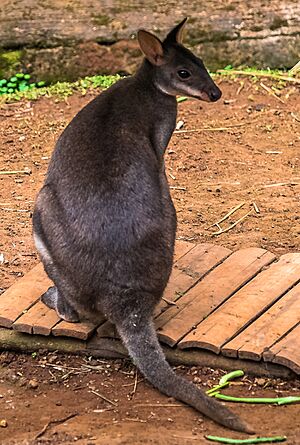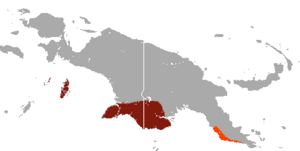Dusky pademelon facts for kids
Quick facts for kids Dusky pademelon |
|
|---|---|
 |
|
| Dusky pademelon in Taman Safari Bogor | |
| Conservation status | |
| Scientific classification | |
| Genus: |
Thylogale
|
| Species: |
brunii
|
 |
|
| Dusky Pademelon range (brown — extant, orange — possibly extinct) |
|
The dusky pademelon is also known as the dusky wallaby. Its scientific name is Thylogale brunii. This animal is a type of marsupial, which means it's a mammal that carries its babies in a pouch. It belongs to the Macropodidae family, which includes kangaroos and wallabies.
Dusky pademelons live on the Aru and Kai islands. They are also found in the Trans-Fly savanna and grasslands area of New Guinea. These animals like to live in warm places. Their natural habitats include dry forests, dry savannas, and dry shrubland. They also live in lowland grasslands. Sadly, their homes are shrinking because of habitat loss. This means they are a threatened species.
Contents
About the Dusky Pademelon
Dusky pademelons are smaller than many other wallabies. They are shy animals that usually live alone. They are mostly active at night, which means they are nocturnal. During the day, they rest in thick bushes or forests.
What They Look Like
Dusky pademelons have soft, thick fur. Their fur is usually a brownish-grey color. They have strong back legs for hopping. Their tails are also strong and help them balance. Like all marsupials, females have a pouch. This pouch is where their young, called joeys, grow and stay safe.
Where They Live
These pademelons are found in specific parts of Oceania. They live on the Aru and Kai islands. These islands are part of Indonesia. They also live in the southern parts of New Guinea. This includes areas in both Papua New Guinea and Western New Guinea.
Their Natural Homes
Dusky pademelons prefer certain types of environments. They like areas with lots of trees and plants. These places give them food and shelter.
- Dry forests: Areas with many trees but not much rain.
- Savannas: Open grasslands with scattered trees.
- Shrublands: Areas covered mostly by bushes and shrubs.
- Lowland grasslands: Flat, grassy areas close to sea level.
These habitats provide them with places to hide from predators. They also find plenty of food there.
Why They Are Important
Every animal plays a role in its environment. Dusky pademelons help keep their habitats healthy. They eat plants, which helps control plant growth. They are also a food source for other animals. This makes them an important part of the food chain.
The Story Behind Their Name
The scientific name for the dusky pademelon is Thylogale brunii. This name honors a special person.
Who Was Cornelis de Bruijn?
The name brunii comes from Cornelis de Bruijn. He was a Dutch painter. He was also an explorer. Cornelis de Bruijn was the first person to describe this animal in detail. He wrote about it in his book called Travels. This book was first published in 1711.
An Old Nickname
In his book, de Bruijn called the animal "philander." This word means "friend of man." It was a common name for the animal back then. Later, people also called it the "Aru Island wallaby." This name came from where the animal lived.
Local Names for the Pademelon
People in different places have their own names for the dusky pademelon.
- In the Kalam language of Papua New Guinea, it is called kutwal or kotwal.
- François Valentyn was another Dutch explorer. He wrote that people on the Aru Islands called it aijir and pelandoe.
- Malaysian people called it pelandok-aru. This means "Aru mousedeer."
- People from Ambonese called it koeskoes-aroe. This means "Aru cuscus." They called it this because it has a pouch, just like a cuscus.
Conservation Status
The dusky pademelon is currently listed as "Vulnerable" (VU) by the IUCN. This means it faces a high risk of becoming extinct in the wild.
Threats to Their Survival
The biggest threat to dusky pademelons is habitat loss.
- Forests are being cut down for farming.
- Land is being cleared for human settlements.
- Hunting is also a problem in some areas.
These activities reduce the places where pademelons can live and find food. It also makes them more exposed to predators.
What Can Be Done
Efforts are being made to protect these animals.
- Setting up protected areas helps save their habitats.
- Educating local communities is also important.
- Controlling hunting can help their numbers recover.
Protecting the dusky pademelon helps keep the balance of nature in its unique home.


